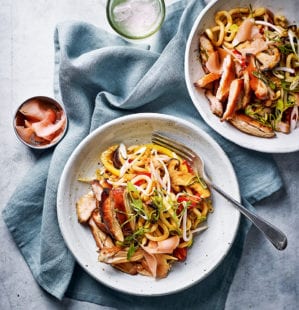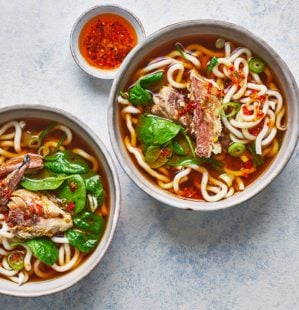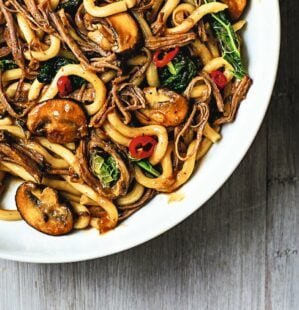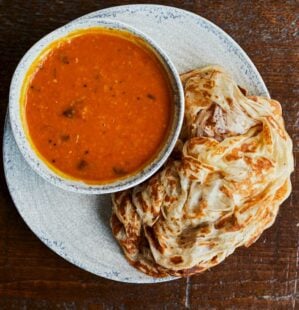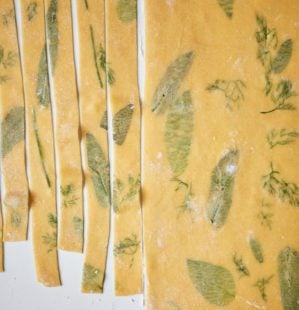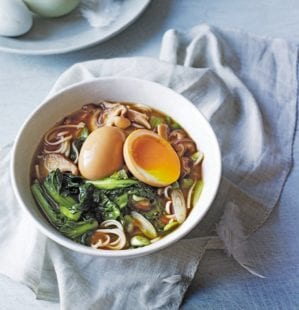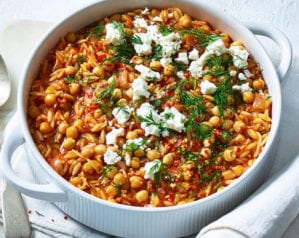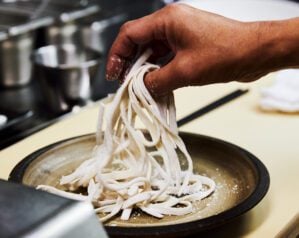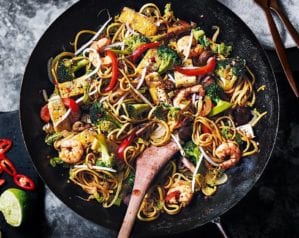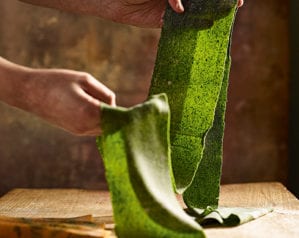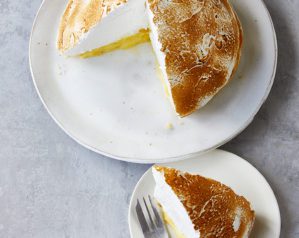
Udon noodles
- Published: 4 Apr 24
- Updated: 12 Apr 24
Homemade udon noodles are bouncier, tastier and far superior to shop-bought. What’s more, you get to use your feet to knead the dough! Because they’re cut rather than pulled or extruded, they’re a fantastic noodle to prepare from scratch. Masaki Sugisaki, executive chef at Dinings SW3 in Chelsea, walks you through the process.
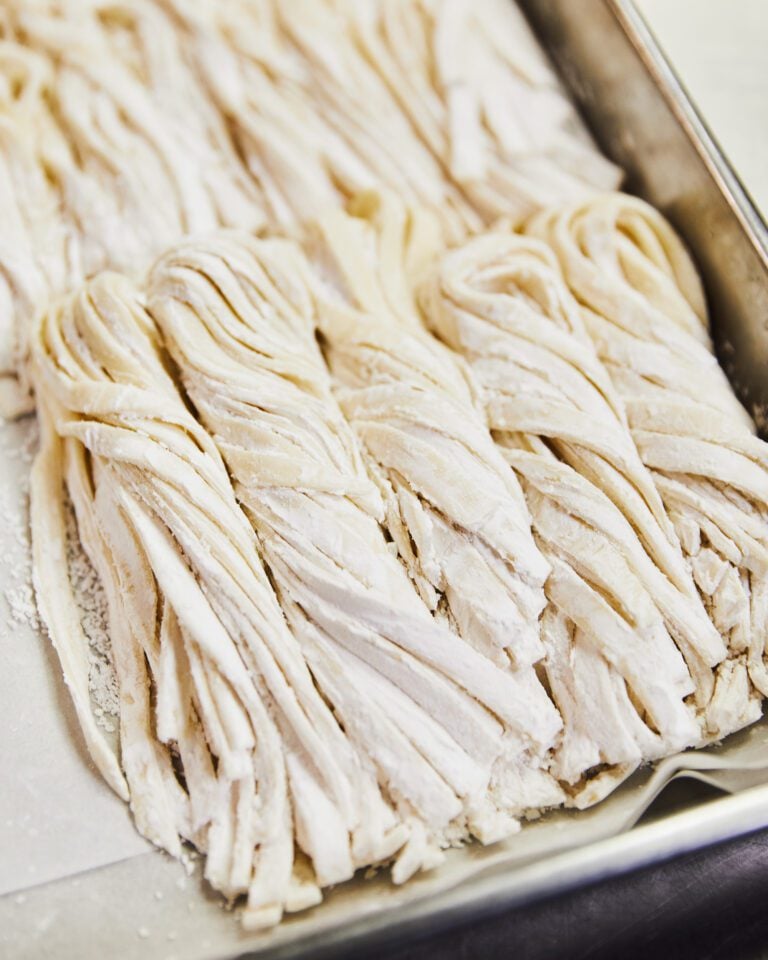
Use your noodles to make Masaki’s comforting, creamy susuru (udon soup with chicken and sesame).
-
Serves 4 (makes about 300g)
-
Hands-on time 1 hour, plus at least 24 hours resting. Simmering time 10 min
Before you start
You need to start making the noodles at least a day before you want to use them. They can be kept in the fridge, covered, for up to 3 days before cooking.
Ingredients
- 200g udon flour or 00 flour
- 12g sea salt
- Tapioca flour/starch or potato starch to dust (see Know-how)
- Ice cold water (for cooking)
Specialist kit
- Large freezer bag
Method
- To make the noodles, sift the flour into a large bowl and make a well in the middle. Measure out 90ml water (see Tips) – ideally at 15°C – then stir in the salt to dissolve. Pour the salted water into the well in the flour and mix with chopsticks until a shaggy dough forms.
- Use your hands to bring the dough into a single piece in the bowl, pressing and squeezing it to ensure there are no pockets of trapped air. Put the dough in a large freezer bag, then use your feet to press and stamp on the dough – don’t fully seal the bag as the air needs to escape. Keep stepping on the dough until it’s an even sheet, as thin as you can get it, then fold the edges back into the centre and form it back into a ball, trying not to trap any air. Repeat the stepping process, then fold the dough back into a ball again. Leave the dough to rest for 15 minutes, covering the opening of the bag with a damp tea towel (see Tips).
- Repeat the stepping and folding twice more, then leave to rest for 2 hours. Repeat the stepping and folding twice more, then leave to rest for 6 hours. Repeat the stepping and folding twice more, then leave to rest for 16 hours.
- Take the dough out of the bag and put it on a large clean work surface. Use a rolling pin to roll it out into a square-ish sheet, about 2mm thick. Dust the sheet with tapioca or potato starch, then gently fold it over itself in a zigzag (dusting the other side) a few times until it’s as long as your knife blade. Cut the dough into 6mm wide ribbons (about the same as tagliatelle), then dust with plenty of tapioca or potato starch (see Tips). You can cook them right away, but they benefit from being divided into nests and rested in the fridge overnight to develop the flavour/texture even further.
- To cook, bring a large pan of water to the boil (see Tips) and set up a large bowl of ice cold water. Cook the noodles in the boiling water for 8-10
minutes, then drain and add to the iced water to halt the cooking process. They’re ready to be used in soups or stir-fries, or simply dressed and enjoyed hot or cold.
- Recipe from April 2024 Issue
Nutrition
- Calories
- 175kcals
- Fat
- 0.5g (no saturated)
- Protein
- 6g
- Carbohydrates
- 37g (no sugars)
- Fibre
- 0g
- Salt
- 0.4g
delicious. tips
Masaki’s tips for great udon
• The amount of water you need depends on how warm it is. I tend to aim for a ratio of 45% in winter (which is what this recipe calls for), but stick to 43% in summer. So
if it’s dry and warm, add around 10ml less.
• Ideally you should use soft water for your udon dough. Hard water can mean your noodles become soggy on the outside before they’re fully cooked. If you live in
a hard water area, use a soft bottled still water from the supermarket such as Tesco Ashbeck, Volvic or Waitrose Essential.
• A lot of salt goes into udon dough – it tightens up the gluten network to help give the noodles their bouncy texture – but most of it is drawn out into the water during cooking, so they won’t taste oversalted.
• The resting times are vital for giving udon their bouncy texture, so don’t skip them. And don’t let the dough dry out – always keep it covered with a clean damp tea towel.
• Dusting the noodles liberally with tapioca starch or potato starch stops them sticking. Shake to remove the excess – it’s better to over-dust, then shake off lots of excess, than under-dust and have sticky noodles.
• A dash of white distilled vinegar in the water when you boil the udon helps to give them a better texture.
• Shocking the noodles in iced water once they’re cooked washes off excess starch and firms them up. They’ll warm through again in hot broth.You need to start making the noodles at least a day before you want to use them. They can be kept in the fridge, covered, for up to 3 days before cooking.
Buy tapioca flour (also sold as tapioca starch) from health food shops such as Holland & Barrett. Buy potato starch from Ocado or other online suppliers.
Buy ingredients online
Rate & review
Rate
Reviews
Subscribe to our magazine
Food stories, skills and tested recipes, straight to your door... Enjoy 5 issues for just £5 with our special introductory offer.
Subscribe
Unleash your inner chef
Looking for inspiration? Receive the latest recipes with our newsletter

